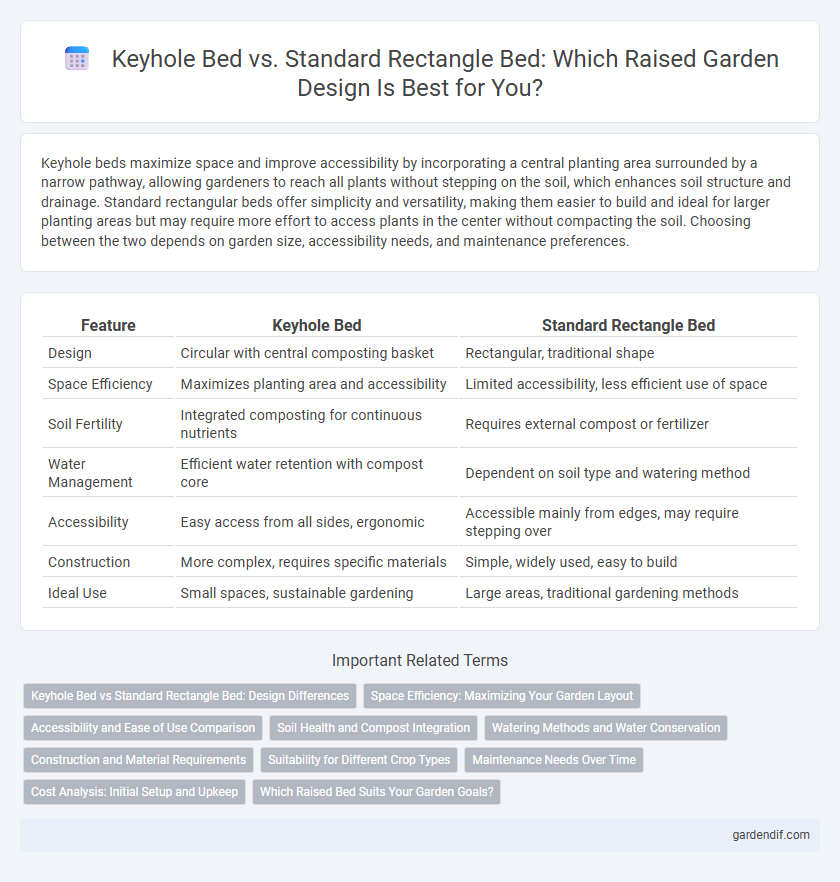
Keyhole bed vs Standard rectangle bed Illustration
Keyhole beds maximize space and improve accessibility by incorporating a central planting area surrounded by a narrow pathway, allowing gardeners to reach all plants without stepping on the soil, which enhances soil structure and drainage. Standard rectangular beds offer simplicity and versatility, making them easier to build and ideal for larger planting areas but may require more effort to access plants in the center without compacting the soil. Choosing between the two depends on garden size, accessibility needs, and maintenance preferences.
Table of Comparison
| Feature | Keyhole Bed | Standard Rectangle Bed |
|---|---|---|
| Design | Circular with central composting basket | Rectangular, traditional shape |
| Space Efficiency | Maximizes planting area and accessibility | Limited accessibility, less efficient use of space |
| Soil Fertility | Integrated composting for continuous nutrients | Requires external compost or fertilizer |
| Water Management | Efficient water retention with compost core | Dependent on soil type and watering method |
| Accessibility | Easy access from all sides, ergonomic | Accessible mainly from edges, may require stepping over |
| Construction | More complex, requires specific materials | Simple, widely used, easy to build |
| Ideal Use | Small spaces, sustainable gardening | Large areas, traditional gardening methods |
Keyhole Bed vs Standard Rectangle Bed: Design Differences
Keyhole beds feature a circular or semi-circular design with a central composting basket, optimizing space and nutrient recycling, whereas standard rectangle beds have a simple linear layout focusing on maximizing planting area. The raised edges of keyhole beds provide easy access from all sides, reducing soil compaction, while rectangle beds often require walking paths for access. Keyhole designs enhance efficiency in water retention and waste breakdown, contrasting with the straightforward, high-capacity planting surface of rectangular beds.
Space Efficiency: Maximizing Your Garden Layout
Keyhole beds optimize space by allowing gardeners to access plants from a central path, reducing wasted walking areas compared to standard rectangle beds. Their circular design with an integrated composting basket enhances soil nourishment while maximizing planting density within a compact footprint. Standard rectangle beds offer straightforward layout but typically require wider pathways, resulting in less efficient use of garden space.
Accessibility and Ease of Use Comparison
Keyhole beds offer superior accessibility by incorporating a central path that allows gardeners to reach all areas without stepping on soil, reducing compaction and making maintenance easier. Standard rectangle beds require walking around or stepping into the bed, which can damage plant roots and limit ease of use. The design of keyhole beds enhances ergonomic access for watering, planting, and harvesting, making them ideal for users with mobility challenges.
Soil Health and Compost Integration
Keyhole beds enhance soil health by maximizing nutrient cycling through a central composting basket, which promotes continuous organic matter decomposition and improved moisture retention. Standard rectangular beds often require separate composting management, leading to less efficient nutrient integration and potential soil compaction. The design of keyhole beds facilitates better aeration and microbial activity, crucial for sustaining long-term soil fertility.
Watering Methods and Water Conservation
Keyhole beds use a central composting basket that waters plants efficiently through deep irrigation, reducing surface evaporation and conserving water more effectively than standard rectangular beds. Standard rectangle beds typically require overhead or drip irrigation systems that may lead to uneven watering and higher water loss due to runoff and evaporation. Keyhole designs optimize water retention and facilitate targeted watering, making them superior for sustainable gardening practices focused on water conservation.
Construction and Material Requirements
Keyhole beds require less construction material due to their circular design with a central composting basket, optimizing soil nutrient distribution and reducing the need for extensive framing. Standard rectangle beds demand straight, sturdy lumber or composite boards to create defined edges and corners, often increasing material usage and waste. Both designs benefit from untreated wood or recycled plastic for durability, but keyhole beds prioritize sustainable construction by minimizing material footprint.
Suitability for Different Crop Types
Keyhole raised beds excel in supporting diverse crop types due to their central composting well, which enhances soil fertility and moisture retention, ideal for nutrient-demanding plants like tomatoes and leafy greens. Standard rectangular beds provide expansive linear space suitable for root vegetables and row planting of crops such as carrots, beans, and peas, facilitating easy access and maintenance. Crop selection depends on bed design; keyhole beds optimize space and compost integration, while rectangular beds support extensive single-crop cultivation.
Maintenance Needs Over Time
Keyhole beds require less maintenance over time due to their efficient design, which centralizes compost and water access, reducing weed growth and improving soil fertility. Standard rectangle beds often need more frequent watering, weeding, and soil amendments as nutrients can be unevenly distributed. The reduced labor in keyhole beds translates to long-term sustainability and ease of care for gardeners.
Cost Analysis: Initial Setup and Upkeep
Keyhole beds typically require higher initial costs due to customized materials and complex design, whereas standard rectangle beds are more cost-effective to set up with readily available resources. Maintenance expenses for keyhole beds can be lower over time because their efficient access reduces soil compaction and labor, while standard rectangle beds may incur higher upkeep costs due to more frequent soil management and access efforts. Evaluating total cost of ownership should consider both upfront investment and long-term maintenance to determine the most economical raised bed option.
Which Raised Bed Suits Your Garden Goals?
Keyhole beds maximize space and accessibility with a central composting area, making them ideal for intensive gardening and sustainable practices. Standard rectangle beds offer simplicity and scalability, suitable for larger plots and traditional row planting. Choosing between a keyhole or rectangle raised bed depends on garden size, crop diversity, and maintenance preferences.
Keyhole bed vs Standard rectangle bed Infographic

 gardendif.com
gardendif.com